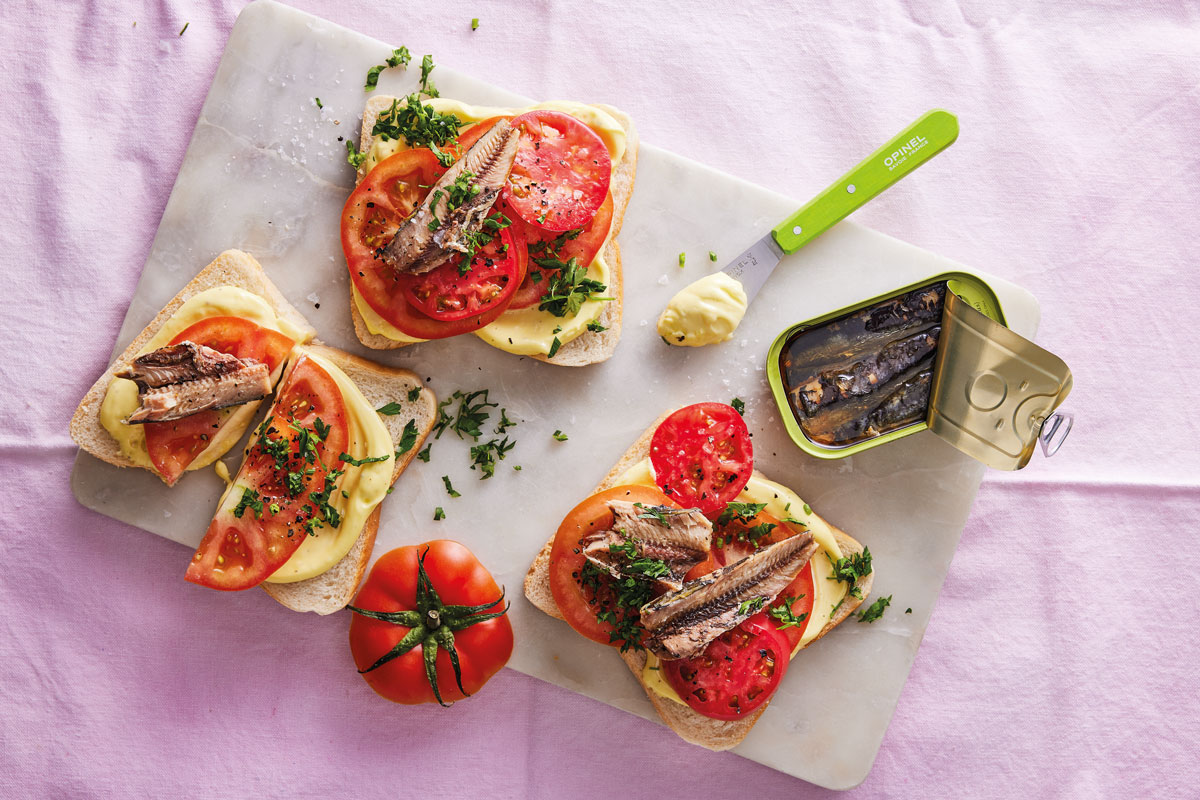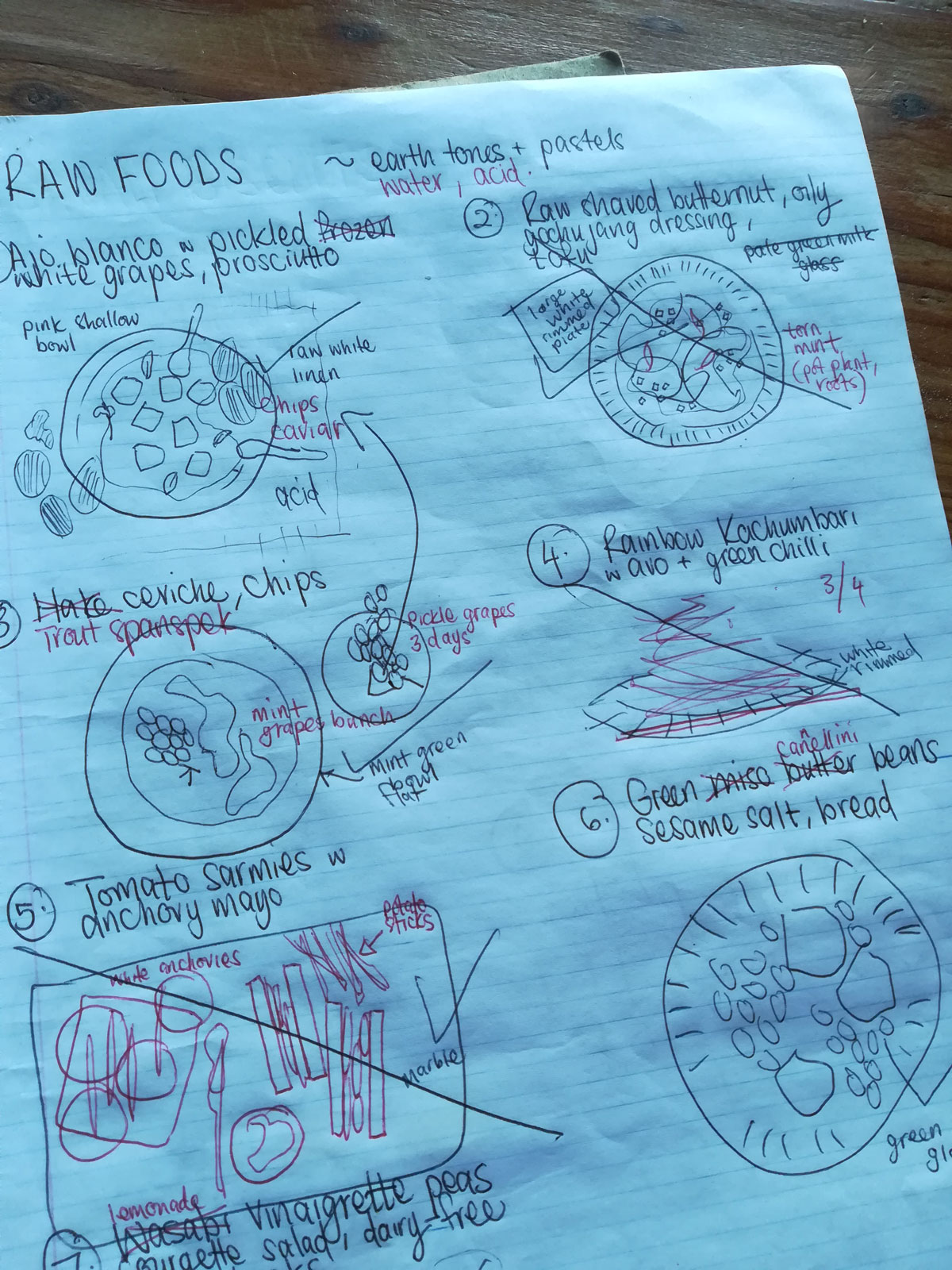How I develop a recipe feature for TASTE
I’m often asked how food features for TASTE magazine come together, and lemme tell you, it’s quite a production. Here’s how we do it – I’ll use my raw feature from the Jan/Feb issue as an example:
1. The inspo
I take my inspiration from a number of places, sometimes I go online and flip through a Delicious or a Bon Appetit and allow some of the dishes to inspire me. I often page through some of our older issues to see if there’s anything I may have missed. If I’m being honest, a lot of inspiration comes from what I want to eat right now. And a lot of the time, I want it to be a combination of classical fare mixed up with something I’ve never seen done before. I often rifle through the fridge and make something that I feel could work in the mag, take a picture or write it down.
View this post on Instagram
2. The brainstorm
Once every two months, we get together as a team and discuss ideas at our bi-monthly Food Nerds brainstorm.
I always look forward to these brainstorms because all the ideas that have been brewing in my mind finally get to see the light of day. It’s where the real fun is had! We’ll discuss trends, and things we’ve seen, heard or eaten that have us all excited. It’s an inspired, free space where we all throw out our best ideas, processed or not. Some are brilliant, others are great, and some don’t always make the cut. To borrow Kath Pope’s words, it’s a lot like throwing spaghetti at the wall and seeing if something sticks.

For our Jan/Feb issue, we decided to focus on different cooking methods, so the issue explored steaming (Clem), grilling (Hannah) and creative ways with the best of summer fruit (Abi). I chose raw – I love stripping food down to its most natural form, it’s how I love to eat, and I relished the challenge to make raw, no-cook dishes look and taste irresistible.
ALSO READ: Kick-start your 2024 with the Jan/Feb issue of TASTE
Like me, our editor Kate, loves a ripe tomato sandwich, so she was excited about my raw tomato sarmies with sardine mayo, and food director Abi liked the ajo blanco with prosciutto and pickled white grapes. So, we move onto phase two – refining my ideas and adding them to a spreadsheet where the rest of the good ideas go. We have the spreadsheet to make sure we don’t have any recipe overlap and that we have a comprehensive selection of dishes spread throughout the mag.

3. Shot planning
Next, I draw little diagrams of how I imagine each dish will turn out. This can be really simple or get pretty detailed, right down to the type of salt I want to sprinkle around the dish to where I want to position props like cutlery and glassware. They don’t always go according to plan, sometimes they’re just a guideline that I end up totally abandoning!

4. Propping
Once I’ve decided on a colour theme, I head to our local prop house, Check My China. It’s a stylist’s paradise owned by fellow stylist Brita du Plessis in the Bo-Kaap – there’s absolutely nothing they don’t have here: dinnerware, tablecloths, all manner of decorations, knick-knacks, glassware and a wide selection of vintage props sourced from all parts of the world. It’s so easy to get lost in that store. Picking out some props to style my feature is kind of my favourite part, because I get access to all these amazing things. For the raw story, I’m looking for whites, earth tones and splashes of pretty pastels, and I manage to find some really beautiful vessels. My chosen props are packed and our driver, the one-and-only Uncle Ronnie delivers them to whichever studio I’ll be shooting at.

5. Recipe writing
I’ll be cooking some of these recipes for the first time, and some have been tested at home. Writing the recipes beforehand helps me put together a shopping list. A version of the baby marrow salad with lemonade vinaigrette is published in my e-book, so I’ve made that one plenty of times. The ajo blanco was new, and it turned out incredibly delicious. I’d also made many varieties of the kachumbari salad; this one was just supercharged with colourful ingredients and a flourish of flowers.

6. Shopping
Then the best BEST part: the shopping! I go to my nearest Woolies (the one at Gardens shopping centre is my favourite) to source all the necessary ingredients to cook my story. I sometimes go a little wild and wide-eyed when I am faced with the wide selection of ingredients and need to reel it in – how many varieties of grapes could possibly exist?
I get the shopping done and drop my ingredients off in studio and head home. I found yuzu tofu in the Asian food aisle, a new ingredient at Woolies. It’s so deliciously creamy and mild – perfect with my oily, spicy gochujang dressing.
@wwtaste POV: You’ve found all of your meals for the week @Woolworths SA @clempedro.mancrave ♬ 哇、惊讶 - Official Sound Studio
7. Shoot day
The next day, my assistant and I start the day nice and early and begin cooking. I stick all my recipes up on the wall so we can both follow along. It’s a total jam, sometimes I don’t believe this is a job!
We have a team of brilliant food assistants, and we each get assigned one on each shoot. They’re all exceptional, but I was lucky enough to work with the very best of them, Ellah Maepa. Ellah is a talented chef and spends most of her time cooking on film sets and as a private chef. She’s an absolute treasure to work with. Follow her on TikTok here.

Once we’ve got a decent number of dishes ready, I start styling shots for the photographer.
8. Styling the shot
I shot the raw story with Myburgh du Plessis. He’s one of the best food photographers in the game and I’ve learned a lot from him. I honestly think I do some of my best work with him. We start the day off slowly, doing lighting tests by photographing some of the props with no food on them. We’ll spend about an hour preparing food before we begin shooting it. I always do things gradually, add elements of a dish one at a time. Once you pour the sauce onto a dish, there’s no going back. So, you’ve got to do it in patient increments.
At first, I taught myself how to style food when Instagram was starting to be a thing – my work looked pretty amateur, naturally, but I knew I was onto something. To sharpen my skills, I would pore over magazines like House and Leisure, Food and Home and Sunday Times Lifestyle, which would have just a couple of recipes in it. Reading and cooking endless recipes also turned me into a recipe developing pro. TASTE was always my favourite. I was inspired by Hannah Lewry, a fellow stylist, and I really enjoyed the freshness, joy and colour in her work. I was always inspired by Abigail’s spontaneity, boldness and the freedom depicted in her images. I am a huge fan of Yewande Komolafe who cooks and writes for the New York Times. Her fresh, fun takes on West African cuisine inspire me to look into my own heritage cuisine and celebrate it. Jax Burgess, who works predominantly on commercial stuff but is known to style a feature for the mag here and there, has got such outstanding style, too. I look up to her and admire her work in a big way.

Working with a food photographer is always so interesting, because each of them has their own unique style. The important thing is to have a mutual respect for one another’s practices, and to be open to feedback. I wasn’t always so thick-skinned. Feedback used to feel like the end of the world to me. But I’ve come a long way and have come to welcome it, as it can only make me a better stylist. Also, feedback isn’t always this scary thing. Sometimes it comes in the form of a word of encouragement, which is always nice to receive. But we never blow smoke up each other’s rears. It’s always honest. Some advice I received after I had to reshoot a feature was “always make sure the food looks immediately recognisable. And delicious!”
People often ask me what happens to the food once we’ve shot it. Duh, guys – we eat it! Normally, halfway through the shoot, we’ll break for lunch and eat some of the dishes we’ve prepared, along with whatever’s for lunch that day. Sometimes, we distribute the food among ourselves. Whatever we don’t eat, I give away to a shelter in my neighborhood.
9. Final details
Afterwards it’s all the boring stuff – my assistant will cost the story so that we can let you, the reader, know how much each dish will cost you to make per serving. The designer will lay out the feature, choosing the strongest images to use full page, and using others small. The recipes are edited –our all-star copy editor Lynda triple-checks every detail – down to whether every ingredient is mentioned in the method, or whether there’s something in a picture not mentioned in a recipe. Then I get a PDF of the feature layout with a few queries. Once I’ve answered those, and final checks have been completed, it’s off to print! That wait is excruciatingly long, but when it finally lands, nothing beats the feeling of holding a freshly printed issue in your hands.
Sometimes, we’ll shoot a video of one of the recipes – if it’s something we think people will respond to online. For the raw story, we shot my green cannellini beans. Video shoots are a different kettle of fish – but that’s a whole other story!
@wwtaste♬ Summer Vibes - GRLN




Comments